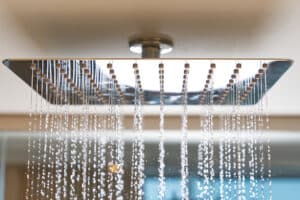
Top 5 Water-Saving Tips
Water-Saving Tips – Are you concerned about water conservation and its impact on our planet? Understanding water-saving tips is crucial as we face increasing global water scarcity issues. With every small change, you can make a big difference in preserving this precious resource. In this article, we will explore the top five water-saving tips that you can easily implement in your home and daily routine.
Water-Saving Tips: Importance of Saving Water
Water conservation is not just a trend; it’s a necessity. As the global population grows, the demand for water increases, but our water resources remain finite. In many parts of the world, communities experience water shortages that affect daily life, agriculture, and industry. By saving water, we help ensure that there is enough to meet everyone’s needs.
Global Water Scarcity Issues
Water scarcity affects more than 40% of the world’s population, a figure expected to rise with climate change and population growth. Many regions, including parts of the United States, face severe droughts, leading to stringent water restrictions. By understanding the scope of water scarcity, we can appreciate the value of every drop and the impact of our conservation efforts.
How Small Changes Make a Big Impact
Simple adjustments in our daily routines can lead to significant water savings. For example, fixing a leaky faucet can save gallons of water each day. Installing water-efficient fixtures, adopting smart lawn care practices, optimizing indoor water use, and cultivating mindful water habits are all practical steps that collectively make a huge difference. Each action, no matter how small, contributes to a larger, more sustainable future.
Water-Saving Tips #1: Fix Leaks Promptly
Did you know that a small leak can waste over 10,000 gallons of water a year? Fixing leaks promptly is one of the most effective ways to conserve water at home. Identifying and repairing common household leaks can save you money and prevent water damage.
Common Types of Household Leaks
Household leaks often occur in faucets, toilets, and showerheads. Dripping faucets are easy to spot, but toilet leaks can be silent and go unnoticed. To check for a toilet leak, add a few drops of food coloring to the tank; if the color appears in the bowl without flushing, there’s a leak. Showerheads can also leak due to worn-out washers or loose connections.
Simple DIY Fixes
Many leaks can be fixed with simple tools and a bit of know-how. Here are some quick DIY solutions:
- Faucet Leaks: Replace worn-out washers and gaskets, or tighten connections.
- Toilet Leaks: Replace the flapper or the entire flush valve assembly if necessary.
- Showerhead Leaks: Apply plumber’s tape to threaded connections or replace the washer.
If you’re not comfortable making these repairs yourself, consider hiring a professional plumber to ensure the job is done correctly.
Long-Term Benefits of Leak Repairs
Fixing leaks promptly not only saves water but also reduces your water bill. Over time, small leaks can lead to significant water waste and higher costs. By maintaining your plumbing, you prevent potential water damage to your home, which can be expensive to repair. Moreover, conserving water contributes to environmental sustainability by reducing the demand on local water supplies.
Water-Saving Tips #2: Install Water-Efficient Fixtures
Are you looking to reduce your water usage effortlessly? Installing water-efficient fixtures is a smart and straightforward solution. These fixtures help conserve water without sacrificing performance, offering long-term savings on both water and energy bills.

Water-Saving Tips: Benefits of Low-Flow Showerheads and Faucets
Low-flow showerheads and faucets are designed to use significantly less water than traditional models. These fixtures can reduce water flow by up to 50%, providing substantial savings without compromising on water pressure. By installing these, you can save thousands of gallons of water each year, leading to lower utility bills and a reduced environmental footprint.
Water-Saving Tips: Guide to Choosing Water-Efficient Appliances
When selecting water-efficient fixtures and appliances, look for the WaterSense label. This certification ensures that the product meets the Environmental Protection Agency‘s (EPA) criteria for water efficiency and performance. Some top choices include:
- Low-Flow Showerheads: Models that use 2.0 gallons per minute (gpm) or less.
- Low-Flow Faucets: Models that use 1.5 gpm or less.
- Water-Efficient Toilets: High-efficiency toilets (HETs) that use 1.28 gallons per flush or less.
Additionally, consider water-efficient dishwashers and washing machines, which use less water per cycle than older models.
Water-Saving Tips: Installation
Installing water-efficient fixtures can be a simple DIY project or a task for a professional plumber. Here are some tips to get started:
- Showerheads and Faucets: Remove the old fixture and apply plumber’s tape to the threads before screwing on the new low-flow model.
- Toilets: If you’re replacing an older toilet, ensure the new high-efficiency model fits your bathroom space and plumbing setup.
- Appliances: Follow the manufacturer’s instructions for installation, and check for proper connections to prevent leaks.
Water-Saving Tips #3: Smart Lawn and Garden Care
Do you want a lush garden without wasting water? Smart lawn and garden care can help you maintain beautiful outdoor spaces while conserving water. By adopting efficient watering techniques, choosing drought-resistant plants, and utilizing mulching and composting, you can reduce your water usage significantly.
Water-Saving Tips: Watering Techniques to Reduce Usage
Proper watering techniques can make a huge difference in water conservation:
- Water Early or Late: Water your lawn and garden in the early morning or late evening to minimize evaporation.
- Deep and Infrequent Watering: Water deeply and less frequently to encourage deep root growth, making plants more drought-resistant.
- Drip Irrigation: Use drip irrigation systems to deliver water directly to the plant roots, reducing water waste.
Water-Saving Tips: Selecting Drought-Resistant Plants
Choosing the right plants is key to a water-efficient garden. Drought-resistant plants require less water and are well-suited to hot, dry climates. Some popular choices include:
- Succulents: Low-maintenance and water-efficient, perfect for arid regions.
- Native Plants: Plants native to your area are adapted to the local climate and require less water.
- Perennials: Many perennials are drought-tolerant and come back year after year, reducing the need for frequent replanting.
Water-Saving Tips: Benefits of Mulching and Composting
Mulching and composting offer numerous benefits for water conservation:
- Mulching: Apply a layer of mulch around plants to retain soil moisture, suppress weeds, and regulate soil temperature. Organic mulches, such as wood chips or straw, break down over time, enriching the soil.
- Composting: Compost improves soil structure, increasing its ability to retain water. Incorporate compost into your garden beds to reduce the need for frequent watering.
Water-Saving Tips # 4: Optimize Indoor Water Use
Are you ready to save water indoors? Optimizing indoor water use is a practical and effective way to conserve water. By making small adjustments in your dishwashing and laundry habits, installing water-saving toilet devices, and recycling greywater, you can significantly reduce your water consumption.
Water-Saving Tips for Efficient Dishwashing and Laundry
Efficient practices in the kitchen and laundry room can lead to substantial water savings:
- Dishwashing: Only run the dishwasher when it’s full. If you wash dishes by hand, use a basin to soak and rinse instead of running the tap continuously.
- Laundry: Always run full loads in the washing machine. Use the appropriate water level setting for the size of the load. Consider upgrading to a high-efficiency washing machine, which uses less water per cycle.
Water-Saving Tips: Using Water-Saving Toilet Devices
Toilets are one of the biggest water users in the home. Water-saving devices can make a big impact:
- Dual-Flush Toilets: These toilets offer two flush options, allowing you to use less water for liquid waste and more for solid waste.
- Toilet Tank Bags: Placing a tank bag in your toilet reduces the amount of water used per flush without affecting performance.
- Low-Flow Toilets: Consider replacing older toilets with low-flow models that use 1.28 gallons per flush or less.
Greywater Recycling Methods
Recycling greywater—wastewater from sinks, showers, and laundry—can reduce your overall water usage:
- Greywater Systems: Install a greywater system to divert water from your bathroom sinks, showers, and laundry for use in irrigation.
- Simple Solutions: Use a bucket to collect water from your shower while it heats up, then use it to water plants.
Optimizing indoor water use not only conserves water but also lowers your utility bills and reduces strain on local water supplies.
Water-Saving Tips #5: Mindful Water Habits
Do you want to make a big impact with small changes? Mindful water habits can help you save water effortlessly. Simple actions, like turning off the tap while brushing your teeth, taking shorter showers, and collecting rainwater for household use, contribute to significant water conservation.
Turning Off Taps While Brushing Teeth
One of the easiest ways to save water is by turning off the tap while brushing your teeth. Leaving the tap running can waste up to 4 gallons of water each time you brush. Instead, wet your brush and fill a cup for rinsing. This small habit change can save thousands of gallons of water annually.
Shorter Showers
Shortening your shower time is another effective way to conserve water. A typical shower uses about 2.5 gallons of water per minute. By reducing your shower time by just 2 minutes, you can save up to 5 gallons of water each time. Installing a water-efficient showerhead can also reduce water usage without compromising on comfort.
Collecting Rainwater for Household Use
Rainwater harvesting is a sustainable practice that can significantly reduce your reliance on municipal water supplies:
- Rain Barrels: Install rain barrels to collect and store rainwater from your roof. Use this water for gardening, washing cars, or even flushing toilets.
- DIY Systems: Set up a simple rainwater collection system using gutters and downspouts to direct water into storage containers.
Mindful water habits are easy to adopt and have a profound impact on your overall water usage. These simple yet effective practices contribute to a sustainable lifestyle and help preserve our precious water resources.
Water-Saving Tips for the Kitchen
Are you aware of how much water is wasted in the kitchen? Water-saving tips for the kitchen can help you cut down on water usage significantly. By adopting efficient cooking and cleaning practices, reusing water, and ensuring full dishwasher loads, you can make your kitchen more sustainable.
Efficient Cooking and Cleaning Practices
Small changes in your cooking and cleaning routines can save a lot of water:
- Cooking: Use only the water you need when boiling or steaming food. Cover pots with lids to reduce evaporation. Reuse cooking water for soups or watering plants once it cools down.
- Cleaning: Scrape dishes instead of rinsing them before placing them in the dishwasher. Soak pots and pans instead of scrubbing them under running water.
Reusing Water in the Kitchen
Reusing water is an excellent way to conserve this vital resource:
- Vegetable Rinsing: Collect water used for rinsing vegetables and use it to water your plants. This water is often nutrient-rich and beneficial for plants.
- Dishwashing: If you hand wash dishes, use the leftover rinse water to pre-soak the next batch of dishes.
Importance of Full Dishwasher Loads
Running the dishwasher only when it is full is one of the easiest ways to save water:
- Efficient Use: Dishwashers use the same amount of water regardless of the number of dishes inside. By waiting until you have a full load, you maximize the efficiency of each cycle.
- Energy Savings: In addition to saving water, full loads also mean fewer cycles, which saves energy and reduces wear and tear on your appliance.
Bathroom Water-Saving Tips
Did you know the bathroom is a major area for water waste? Implementing bathroom water-saving tips can help you conserve water and reduce your utility bills. From installing low-flow fixtures to reducing shower time and fixing toilet leaks, small changes can lead to significant savings.
Low-Flow Fixtures
Low-flow fixtures are designed to use less water without sacrificing performance:
- Showerheads: Low-flow showerheads use 2.0 gallons per minute (gpm) or less, compared to standard ones that use up to 2.5 gpm.
- Faucets: Low-flow faucet aerators can reduce water flow to 1.5 gpm or less, helping you save water without noticing a difference in pressure.
Reducing Shower Time
Shortening your shower time can make a big impact on water usage:
- Time Your Showers: Aim to keep showers under 5 minutes. Using a shower timer can help you track and reduce shower length.
- Music Method: Play a 5-minute song while you shower to help keep track of time.
Fixing Toilet Leaks
Toilets can waste a significant amount of water through leaks:
- Detecting Leaks: Add a few drops of food coloring to the toilet tank. If the color appears in the bowl after 10-15 minutes without flushing, there’s a leak.
- Repairing Leaks: Replacing the flapper or the entire flush valve assembly can fix most leaks. If you’re unsure how to do this, consider hiring a plumber.
Garden and Lawn Irrigation Techniques
Want to keep your garden lush while saving water? Garden and lawn irrigation techniques can help you maintain a beautiful outdoor space without wasting water. By using drip irrigation systems, watering at the right times, and maintaining soil moisture, you can significantly reduce your water usage.
Drip Irrigation Systems
Drip irrigation is an efficient way to water your garden:
- How It Works: Drip irrigation systems deliver water directly to the plant roots through a network of tubes, emitters, and valves.
- Benefits: This method minimizes evaporation and runoff, ensuring that water goes where it’s needed most. It also reduces weed growth by limiting water to the target plants.
Best Times to Water
Timing your watering can make a significant difference in water conservation:
- Early Morning or Late Evening: Watering during these times reduces evaporation and allows water to soak into the soil more effectively.
- Avoiding Windy Days: Watering on windy days leads to increased evaporation and uneven water distribution.
Soil Moisture Maintenance
Maintaining soil moisture is key to efficient water use:
- Mulching: Apply a layer of mulch around plants to retain moisture, suppress weeds, and regulate soil temperature.
- Composting: Incorporate compost into your soil to improve its water-holding capacity and provide essential nutrients to your plants.
Seasonal Water-Saving Tips
Do you adjust your water usage with the seasons? Seasonal water-saving tips can help you adapt your water conservation efforts throughout the year. By preparing for dry spells, adjusting your water use, and performing seasonal maintenance, you can ensure efficient water use all year long.
Adapting Water Use by Season
Water needs change with the seasons, and adapting your water use can lead to substantial savings:
- Spring and Summer: Focus on outdoor water use. Water your garden in the early morning or late evening to minimize evaporation. Use mulch to retain soil moisture.
- Fall and Winter: Reduce outdoor watering as plants enter dormancy. Insulate outdoor pipes to prevent freezing and bursting. Focus on indoor water efficiency.
Preparing for Dry Spells
Preparation is key to managing water use during dry spells:
- Rainwater Harvesting: Install rain barrels to collect and store rainwater during wetter months for use during dry periods.
- Soil Health: Improve soil with compost and organic matter to increase its water-holding capacity, reducing the need for frequent watering.
- Drought-Resistant Plants: Choose plants that require less water and are well-suited to your local climate.
Seasonal Maintenance for Water Systems
Regular maintenance ensures your water systems run efficiently:
- Irrigation Systems: Check for leaks, clogged emitters, and broken sprinklers. Adjust sprinkler heads to avoid watering sidewalks and driveways.
- Plumbing: Inspect for leaks and insulate pipes to prevent freezing. Clean out gutters and downspouts to ensure proper water flow.
- Appliances: Service water-using appliances to maintain efficiency and prevent leaks.

FAQ on Water-Saving Tips
- How much water can I save by fixing leaks?
Fixing leaks can save a significant amount of water. A dripping faucet can waste over 3,000 gallons per year, while a leaking toilet can waste up to 200 gallons per day. Promptly repairing leaks can lead to substantial water and cost savings.
- What are the best water-saving devices for my home?
Some of the best water-saving devices include low-flow showerheads and faucets, dual-flush toilets, faucet aerators, and smart irrigation systems. These devices can significantly reduce water usage without sacrificing performance.
- How can I make my garden more water-efficient?
To make your garden more water-efficient, use drip irrigation systems, water plants in the early morning or late evening, choose drought-resistant plants, and apply mulch to retain soil moisture. These practices can help you maintain a lush garden while conserving water.
- What are some easy ways to save water indoors?
Easy ways to save water indoors include fixing leaks, installing low-flow fixtures, taking shorter showers, only running dishwashers and washing machines with full loads, and using water-saving toilet devices. These small changes can lead to significant water savings.
- How does using water-efficient appliances help conserve water?
Water-efficient appliances, such as Energy Star-rated dishwashers and high-efficiency washing machines, use less water per cycle compared to older models. This not only conserves water but also reduces your energy consumption and lowers utility bills.



















